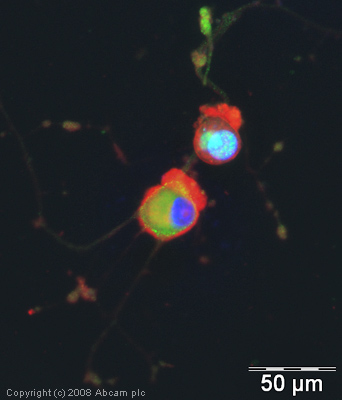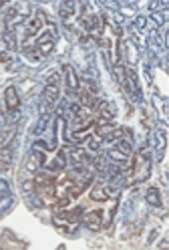Anti-FOXO3A (phospho S253) antibody
| Name | Anti-FOXO3A (phospho S253) antibody |
|---|---|
| Supplier | Abcam |
| Catalog | ab31109 |
| Prices | $385.00 |
| Sizes | 100 µg |
| Host | Rabbit |
| Clonality | Polyclonal |
| Isotype | IgG |
| Applications | WB ICC/IF ICC/IF IHC-P IP |
| Species Reactivities | Mouse, Rat, Human, Pig, Zebrafish |
| Antigen | Synthetic peptide conjugated to KLH derived from within residues 200 - 300 of Human FOXO3A |
| Blocking Peptide | Human FOXO3A (phospho S253) peptide |
| Description | Rabbit Polyclonal |
| Gene | FOXO3 |
| Conjugate | Unconjugated |
| Supplier Page | Shop |
Product images
Product References
Fas/CD95 deficiency in ApcMin/+ mice increases intestinal tumor burden. - Fas/CD95 deficiency in ApcMin/+ mice increases intestinal tumor burden.
Guillen-Ahlers H, Suckow MA, Castellino FJ, Ploplis VA. PLoS One. 2010 Feb 5;5(2):e9070.
FOXO3a is broadly neuroprotective in vitro and in vivo against insults implicated - FOXO3a is broadly neuroprotective in vitro and in vivo against insults implicated
Mojsilovic-Petrovic J, Nedelsky N, Boccitto M, Mano I, Georgiades SN, Zhou W, Liu Y, Neve RL, Taylor JP, Driscoll M, Clardy J, Merry D, Kalb RG. J Neurosci. 2009 Jun 24;29(25):8236-47.
![FOXO3A was immunoprecipitated using 0.5mg PC12 whole cell extract, 5µg of Rabbit polyclonal to FOXO3A and 50µl of protein G magnetic beads (+). No antibody was added to the control (-).The antibody was incubated under agitation with Protein G beads for 10min, PC12 whole cell extract lysate diluted in RIPA buffer was added to each sample and incubated for a further 10min under agitation.Proteins were eluted by addition of 40µl SDS loading buffer and incubated for 10min at 70°C; 10µl of each sample was separated on a SDS PAGE gel, transferred to a nitrocellulose membrane, blocked with 5% BSA and probed with ab31109.Secondary: Mouse monoclonal [SB62a] Secondary Antibody to Rabbit IgG light chain (HRP) (ab99697).Band: 63kDa; FOXO3A](http://www.bioprodhub.com/system/product_images/ab_products/2/sub_2/20547_ab31109-195102-IPV020ab311093m.jpg)


